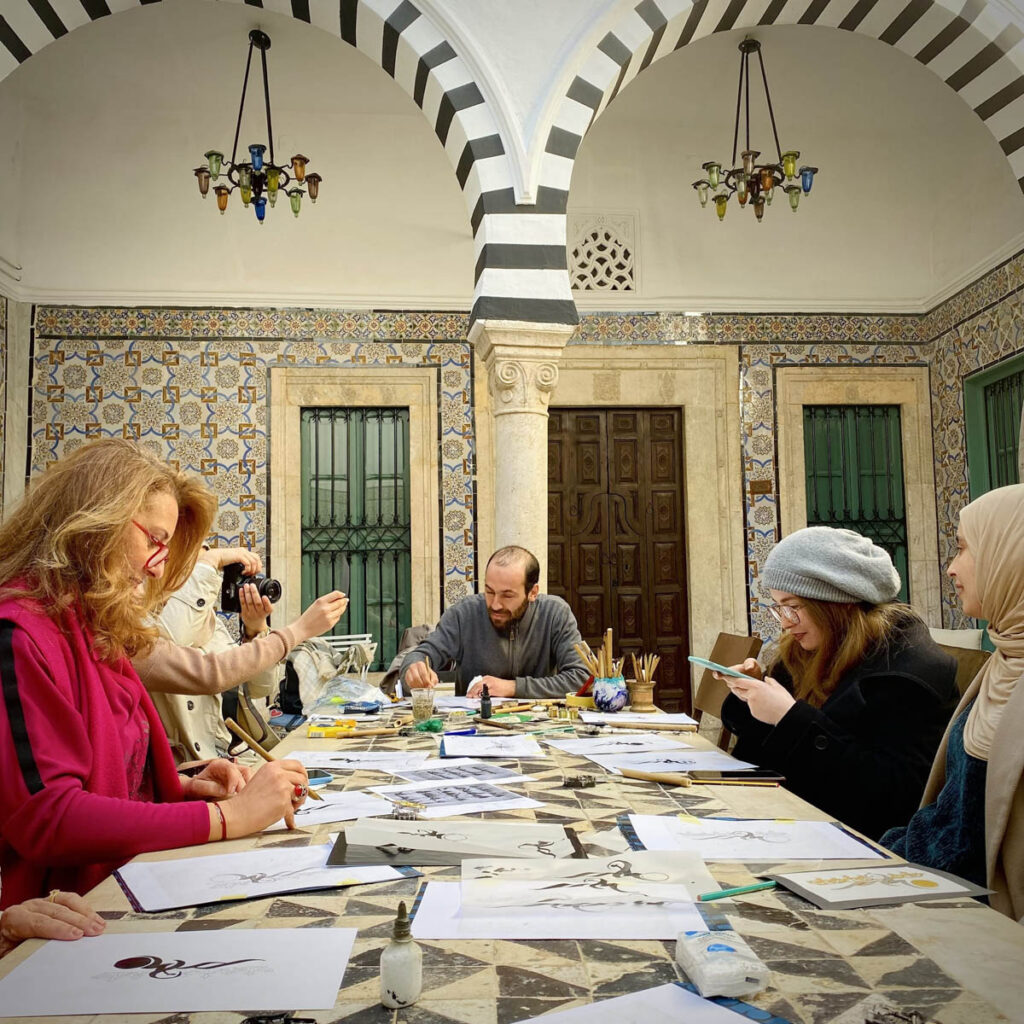
Bifolium from the “Nurse’s Qur’an” (Mushaf al-Hadina), Ink, opaque watercolor, and gold on parchment, 1019 CE, 45 x 60 cm, http://www.metmuseum.org/art/collection/search/456074
Leila Ben-Gacem finds a calligraphic group today in Kairouan that is inspired by the city’s classic eleventh-century work, “Quran of the Nurse”.
Around 1019, in the Tunisian city of Kairouan, there was a lady called Fatimah. Fatimah was the nurse of Ibn Badis, from the Zirid court, which ruled much of North Africa, at the time. Fatmah, famous as ‘the nurse’, wanted to donate a Mushaf (written copy of the Quoran), to the great mosque of Kairouan, as a charitable act of ‘waqf’ (endowment). To donate a Mushaf, she had to hire calligraphers, to produce the manuscript. Her Mushaf becomes known as ‘Mushaf el Hathina’, or ‘Quran of the Nurse, making her probably the most famous child caregiver, in history, thanks to her famous Quran.
According to the “waqf deed” stored with the Quran of the Nurse, calligraphers Al Warraq and Dorra Al Katiba, are probably the calligraphers that produced the manuscript, a gentleman and a lady. When looking carefully at the manuscript, it is hard to decide, whether they were producing a piece of art or a religious document. What is certain, there was no limit to their production budget; as if The Nurse, asked them to make the best masterpiece they could produce.
The Qur’an of the Nurse is a unique manuscript that was written, illuminated and bound in Kairouan in the early eleventh century when the city was still part of the Fatimid Empire. It is a massive three-thousand-leaves codex. The manuscript has about 2900 pages, 44.4 by 30cm each, in vertical format. Each, almost poster-size page, has just five written sentences, 6cm in height, with one or two words per sentence. To produce the pages of this massive manuscript, probably skins of a herd of sheep were used. As for the writing and Islamic page decorations, it probably required a few kilograms of gold and a few litres of coloured ink.
The calligraphers, spend about one year writing the manuscript. The calligraphic style used in to write “Quran of the Nurse” is called Kairouani Arabic calligraphy, which was invented by the calligraphers of this manuscript. Kairouani Arabic calligraphy, was inspired by the Kufi style, and was named after the city of Kairouan. The calligraphers, allowed themselves to design a new font script, remove all dots of letters with dots, and coloured all tashkil (diacritics). Quran verse markings, and Surah headings, are decorated in golden ornaments, inspired by Byzantine and Roman decoration shapes. The freedom by which, the calligraphers expressed themselves in the manuscript, reflects a time, when artistic expression, through manuscript production, was very much affluent.
Each page of the Quran of the Nurse could be considered a piece of art by itself. Some pages made their way out of Tunisia and are currently exposed at the Metropolitan Museum in New York, The David Collection in Copenhagen and the Bardo Museum in Tunis. Yet, the most important part is preserved at the ‘Musée national d’art islamique de Raqqada’, Kairouan, and has not left the city since mediaeval times, for a millennium.
This Qur’anic manuscript constitutes a major piece of Islamic art. Its opulence, the beauty and singularity of its script, and the context of its production and endowment, make it a rare –if not unique- witness of the lively and elaborate cultural, intellectual and courtly scenes of late Fatimid era in the Maghreb.

About a century ago, when Fatimah commissioned Al Warrak and Dorra Al Katiba, to produce the manuscript, her intentions might have been to make a good deed, through her very lavish endowment. Maybe she wanted to prove a certain social or political status, at her time. Nevertheless, she probably did not expect that she would be remembered for liberating artistic talents and giving the name of her city to the only Arabic calligraphy type, named after a North African city name.
Today, the interest group Mdinti organizes Kairouani calligraphy master classes and workshops for Arabic calligraphy beginners, or professionals. Mdinti also organizes long stays in Tunis, for those who want to master Arabic calligraphy. Thanks to the Tunisian Association of Calligraphic Arts, the Kairouani font style, has been studied and documented. They continuously organize workshops, classes and exhibitions, of Kairouani calligraphic arts. Gypsum carvers have also used Kairouani calligraphy, in restoring ceilings of old houses in the medina of Tunis.
Reference
Sihem Lamine, 2013, The Qur’an of the Nurse: A step towards the invention of Maghribi script? unpublished
Leila Ben-Gacem is the owner of the boutique Tunisian hotel, Dar Ben Gacem


